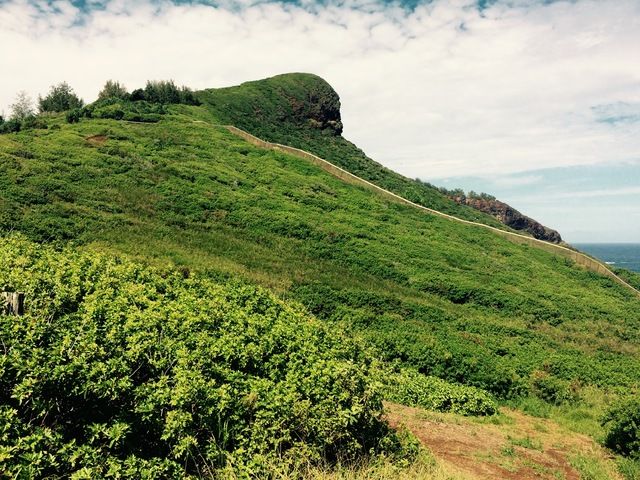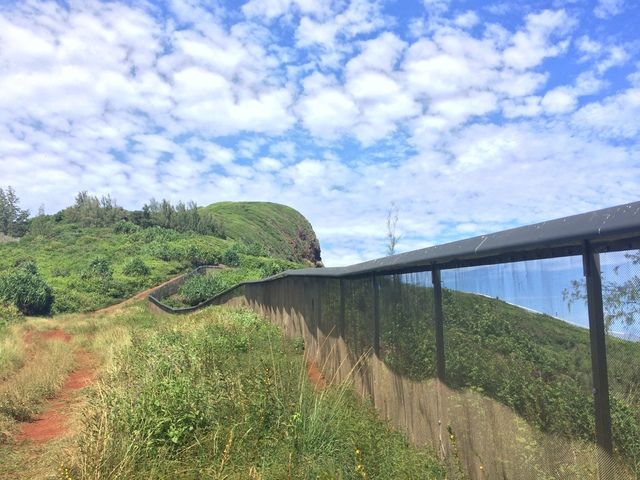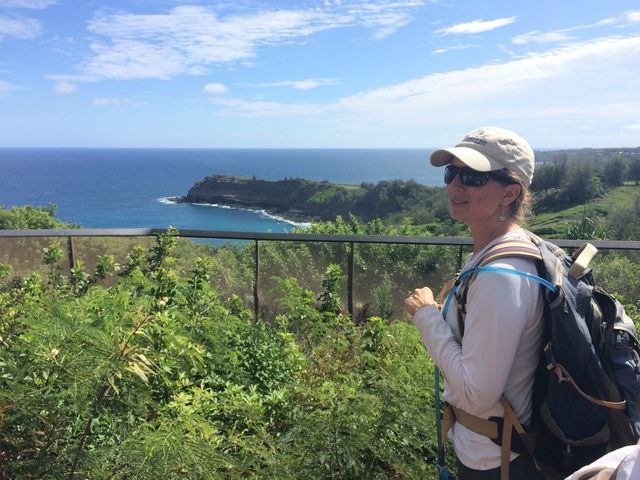KILAUEA — Lindsay Young spied a yellow canary on the ground near her sneaker. It was dead. Notably, the bird’s body was intact. She smiled. “I love it when I find dead things that are still in one piece,” she
KILAUEA — Lindsay Young spied a yellow canary on the ground near her sneaker. It was dead. Notably, the bird’s body was intact.
She smiled.
“I love it when I find dead things that are still in one piece,” she said, picking up the bird with her thumb and forefinger and displaying it in front of her face. “It means that nothing is eating them.”
Young, who is a biologist, dropped the bird where she found it and continued leading a public tour attended by 10 conservation enthusiasts over to the main attraction: 50 underground burrows. In a few weeks, if all goes well, 10 threatened seabirds will be translocated into the man-made holes in the ground from their own burrows on the slopes of Kauai’s mountains, christening a new eight-acre refuge at Nihoku.
The Monday morning tour marked the first and probably last time the public will have access to the planned sanctuary before the birds arrive.
It isn’t canaries that the refuge aims to protect. Rather, it’s the night-flying, endangered Newell’s shearwater and vulnerable Hawaiian petrel that are the objects of the ecosystem restoration project.
These ground-nesting native birds are most threatened by introduced predators such as rats and cats that prey on birds and eat the seeds of native plants. In the forest, where the birds burrow naturally, predators roam freely. But they no longer exist in a barren, bowl-shaped area of ocean-facing land at Nihoku, popularly known as Crater Hill.
It’s all thanks to a $300,000 fence.
“All fences are ugly, there’s no way around that.” said Young, who is the Nihoku restoration project coordinator through her capacity as the executive director of the Honolulu-based Pacific Rim Conservation. “But this one does beautiful things. It completely seals predators out.”
How does she know it works? On the Big Island several years ago a group of conservationists built a fenced enclosure and put inside an array of seabird predators — cats, dogs, rats, mice, pigs, mongoose and rabbits.
“We called it the fence Olympics,” Young said. “We put them all inside the fence to see them try to get out and we video taped what was going on. Every time an animal got out, we analyzed how it got out using the video footage and then adjusted the fence accordingly.”
What conservationists came up with was a fence that stands six-and-a-half feet tall, so that cats can’t jump over it. There’s a hood at the top of the fencing that prevents cats from climbing over it. Tiny mesh chain links keep even the tiniest two-day-old rodents from squeezing through. A modest layer of lightly buried skirting extending out from the bottom of the fence blocks rabbits from digging underneath it.
The predator-proof fence is the second in Hawaii, with the first having been erected four years ago at Kaena Point on Oahu’s North Shore.
Of course, a predator-free zone is only as valuable as the birds inside of it. So in November, conservationists will hike into the mountains where there are cameras recording activity at the site of about 100 burrows belonging to Newell’s shearwater and Hawaiian petrel. Some of the birds that have not yet left their burrows will be carefully removed and transported via helicopter to the carefully designed, fenced-in burrows at Nihoku.
“When they come out of their burrows for the first time, they use the constellations, the star patterns, to imprint on that location,” Young said. “So if you get there before they come out and see the sky for the first time and bring them to a new site, they will return to that site.”
Nihoku was chosen as the refuge location because of it’s topography. The concave terrain collects wind, which the seabirds need to catch in order to take their inaugural flight out to sea.
“We pretty much picked the worst spot for them plant-wise,” Young said. “Everything in there is an invasive species. There are literally no native plants there. But everything else was perfect.”
To that end, the National Tropical Botanical Garden is helping restore the area with native plantings, one acre at a time. A small section of weeds have been removed and replaced with manienie grass, which so far have attracted the beaks of hungry nene.
“It’s kind of tricky because we want to provide cover for the birds,” said Mike DeMotta, NTBG’s assistant director of living collections and horticulture, “but we don’t want to block the flight paths.”
Though the mission of the refuge is to provide Newell’s shearwater and Hawaiian petrel with a safe ground-nesting zone, conservationists hope other birds, such as the nene and the red-footed booby, will make use of the area as well.
The refuge is large enough to host thousands of birds. But the project keepers are starting small. They will monitor the success of the translocation of the first 10 birds before moving any more.
“This has been done many times with different species in New Zealand, and we’ve studied it there so we know that it works,” Young said. “But it’s sensitive.”




